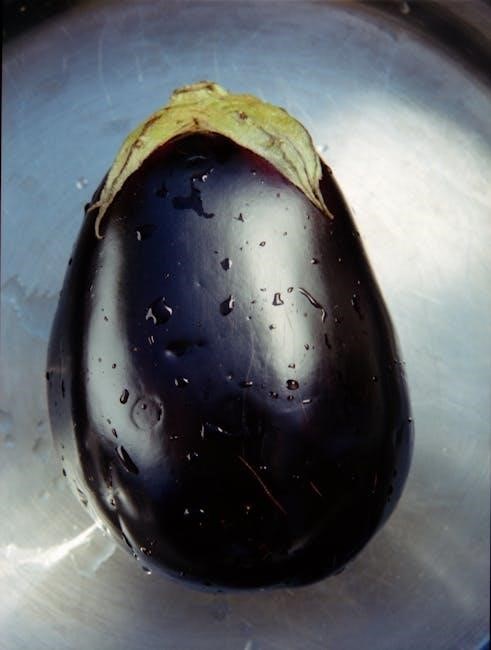Nightshade vegetables are commonly consumed‚ with thousands of varieties existing‚ including edible and non-edible types‚ and can be found in many diets around the world naturally.
Definition and Types of Nightshades
Nightshades are a group of plants that belong to the Solanaceae family‚ with a wide range of species‚ including vegetables‚ fruits‚ and herbs. The term nightshade refers to the poisonous nature of some plants in this family‚ such as belladonna. There are thousands of nightshade species‚ but only a few are edible and commonly consumed. These edible nightshades include popular vegetables like tomatoes‚ potatoes‚ and eggplant‚ as well as fruits like tomatoes and peppers. The definition of nightshades is often associated with the Solanaceae family‚ which is a large and diverse group of plants. Nightshades can be found in many different parts of the world and are often used in various cuisines. They are also known for their nutritional value and are a good source of essential vitamins and minerals. Nightshades are a significant part of many diets.

Edible Nightshades
Edible nightshades include tomatoes and potatoes commonly consumed.
Common Edible Nightshades
Common edible nightshades include a variety of foods such as tomatoes‚ potatoes‚ and peppers. These foods are staples in many diets around the world and are often consumed on a daily basis. They can be found in a range of dishes‚ from savory meals to sweet snacks. Some other common edible nightshades include eggplant and gooseberries. These foods are not only delicious but also provide important nutrients and health benefits. They are rich in antioxidants and fiber‚ making them a great addition to a healthy diet. By incorporating these common edible nightshades into meals‚ individuals can add variety and nutrition to their diet. Additionally‚ they can be prepared in a range of ways‚ making them a versatile ingredient for many recipes. Overall‚ common edible nightshades are a great way to add flavor and nutrition to meals.

Importance of Knowing Nightshades
Knowing nightshades is crucial for health and dietary reasons‚ affecting overall well-being naturally always.
Avoiding Nightshades for Health Reasons
Avoiding nightshades is essential for individuals with specific health conditions‚ as they can exacerbate symptoms and cause discomfort. Certain nightshades‚ such as tomatoes and peppers‚ contain high levels of alkaloids‚ which can be detrimental to health. By being aware of the types of nightshades and their potential effects‚ individuals can make informed decisions about their diet. A list of nightshade vegetables can be a valuable resource for those looking to avoid these foods. Additionally‚ understanding the importance of food labels and being able to identify nightshades in different forms‚ such as spices and extracts‚ can help individuals make healthier choices. This knowledge can be particularly beneficial for those following a specific dietary protocol‚ such as the autoimmune protocol. Overall‚ avoiding nightshades for health reasons requires a combination of awareness‚ education‚ and careful planning.

Nightshade Food List
The list includes various nightshade foods‚ such as vegetables‚ fruits‚ and spices‚ available as a downloadable PDF document for easy reference always online.
Downloading the List as a PDF
To access the list of nightshade vegetables‚ users can download a PDF document‚ which provides a comprehensive overview of the various types of nightshades‚ including vegetables‚ fruits‚ and spices. This document is available for free and can be easily downloaded from the internet. The PDF list includes a wide range of nightshade foods‚ such as tomatoes‚ potatoes‚ and eggplant‚ as well as lesser-known nightshades like gooseberries and peppers. By downloading the list as a PDF‚ users can easily print it out or save it to their device for future reference. The document is regularly updated to ensure that it remains accurate and informative‚ making it a valuable resource for anyone looking to learn more about nightshade vegetables and their potential impact on health. The list is easy to navigate and understand.
Preparation and Consumption of Nightshades
Cooking methods like baking and steaming reduce alkaloid levels in nightshades slowly and naturally always.
Reducing Alkaloid Concentration in Nightshades
To minimize the alkaloid content in nightshades‚ it is essential to choose ripe vegetables‚ as unripe or green ones contain higher levels of these compounds‚ which can be reduced through proper cooking methods‚ such as baking‚ roasting‚ or steaming‚ and by removing seeds and skins‚ where most of the alkaloids are concentrated‚ and by cooking them for a longer period‚ the alkaloid concentration can be further reduced‚ and it is also recommended to cook nightshades in large amounts of water‚ which can help to dilute the alkaloids‚ and then discard the water‚ and this process can be repeated several times to achieve the desired level of alkaloid reduction‚ and by following these steps‚ individuals can enjoy nightshades while minimizing their potential negative effects‚ and it is always a good idea to consult with a healthcare professional or a registered dietitian for personalized advice on reducing alkaloid concentration in nightshades.
Alternatives and Substitutions for Nightshades
Find suitable replacements for nightshades in various recipes and meals naturally.
Nightshade-Free Food Options
There are numerous nightshade-free food options available‚ including a variety of fruits‚ vegetables‚ and herbs. Some examples of nightshade-free vegetables include leafy greens‚ such as spinach and kale‚ as well as cruciferous vegetables like broccoli and cauliflower. Additionally‚ many types of citrus fruits and berries are naturally nightshade-free. When shopping for nightshade-free foods‚ it is essential to read labels carefully and be aware of potential hidden ingredients. Many online resources and recipes are available to help individuals navigate a nightshade-free diet and find suitable alternatives to their favorite foods. By exploring these options‚ individuals can maintain a balanced and healthy diet while avoiding nightshades. With a little creativity and planning‚ a nightshade-free lifestyle can be easy to adopt and maintain over time.

Risks and Considerations of Avoiding Nightshades
Avoiding nightshades may lead to nutrient deficiencies if not planned carefully and properly.
Potential Nutrient Deficiencies from Avoiding Nightshades
Avoiding nightshades can lead to nutrient deficiencies if not properly planned‚ as these vegetables are rich in various essential vitamins and minerals. A well-planned diet is necessary to ensure adequate nutrition. Nightshades are a good source of fiber‚ vitamin C‚ and potassium‚ among other nutrients. A person avoiding nightshades should consume alternative foods that provide these essential nutrients to maintain good health. It is important to consult a dietician or a healthcare professional for personalized advice on avoiding nightshades and ensuring adequate nutrition. They can help create a balanced diet that meets the individual’s nutritional needs. By doing so‚ one can minimize the risk of nutrient deficiencies and maintain overall health and well-being. Regular monitoring of nutrient levels is essential to prevent deficiencies.